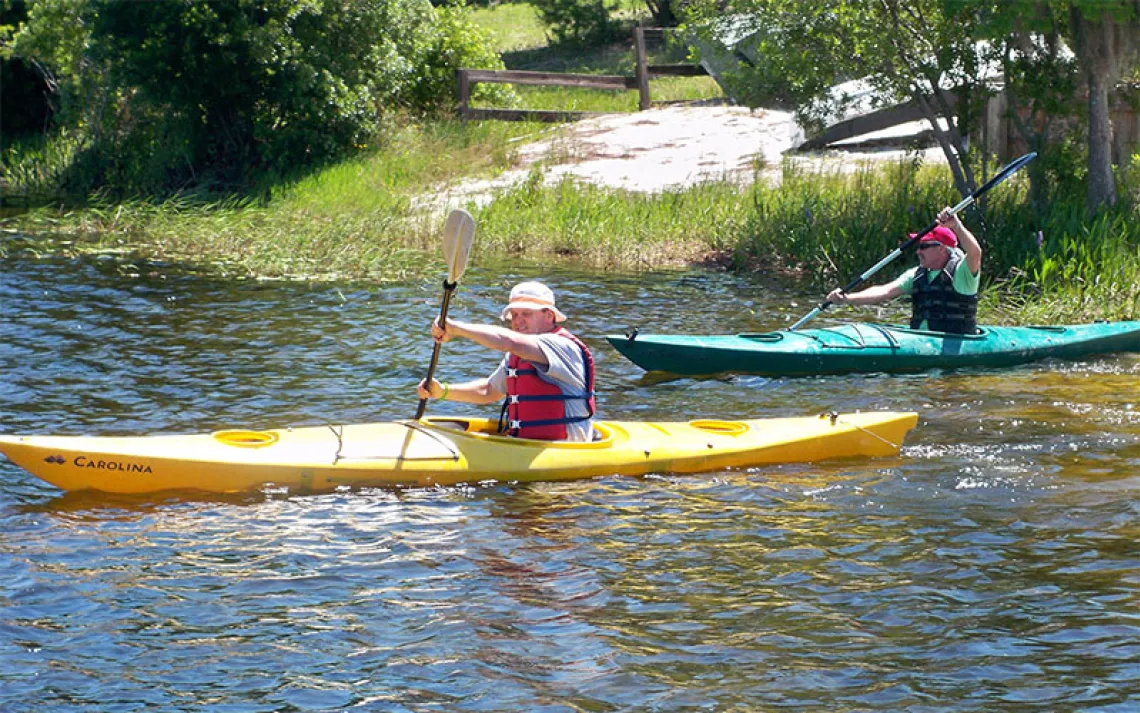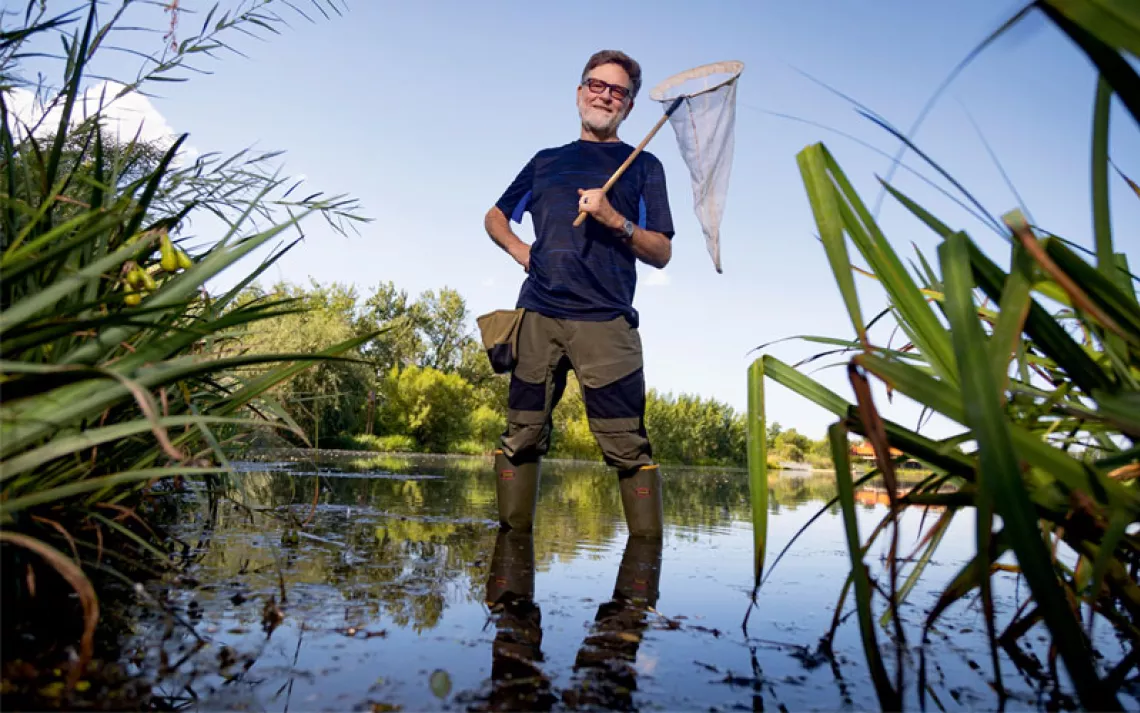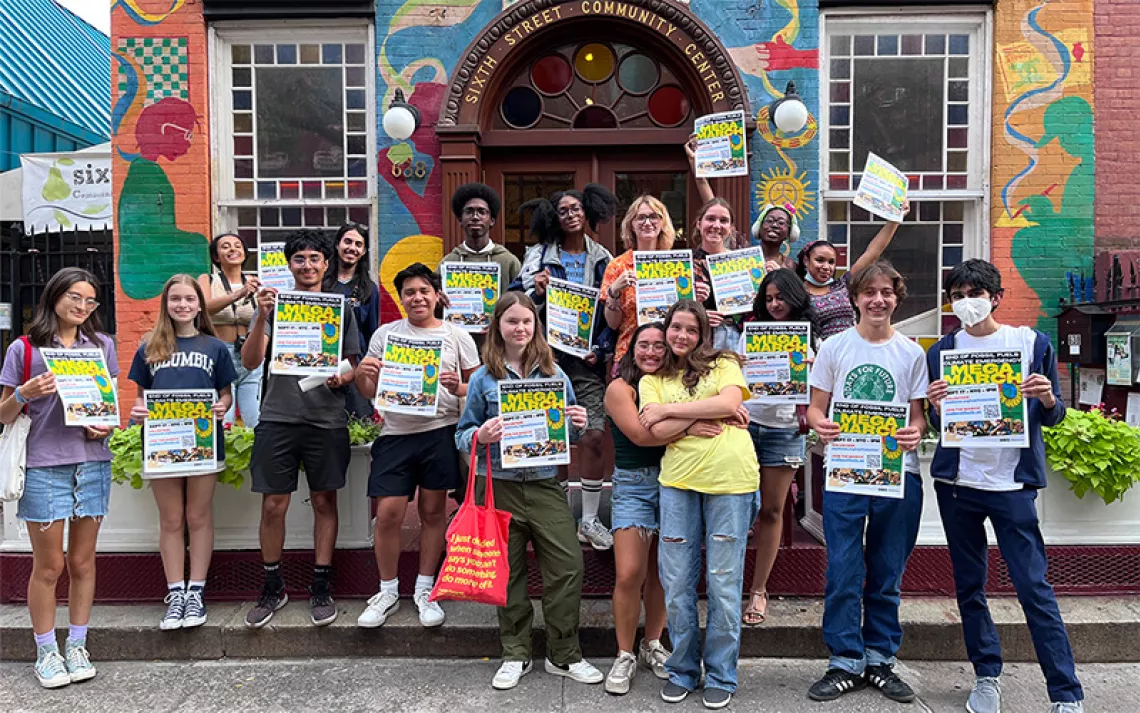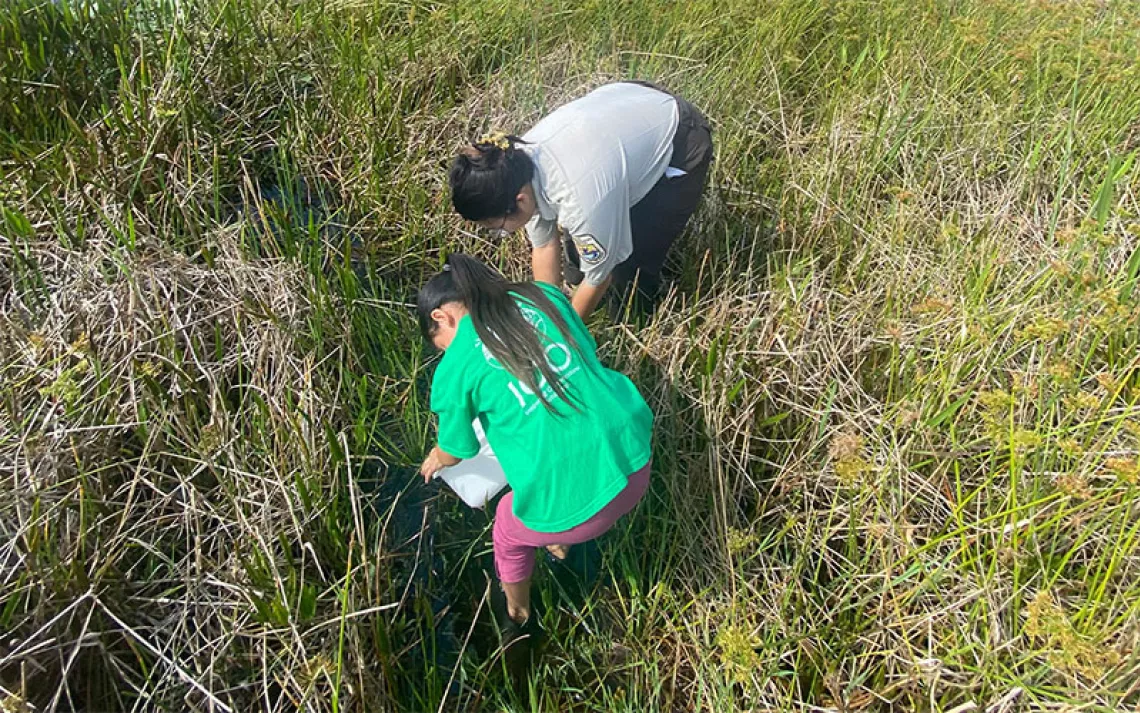City Kids Unplugged
These Seattle students don't know much about their school's iconic namesake, but they learn to share the bearded white guy's love of the wild
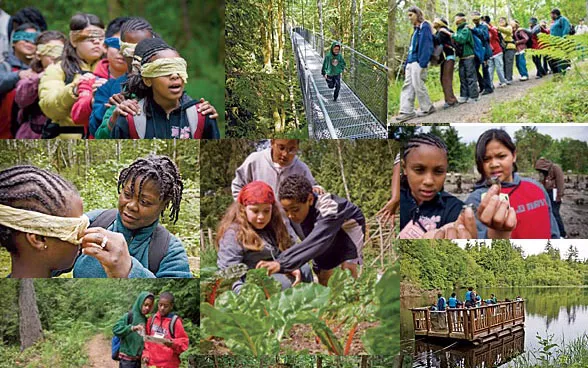
Kids from John Muir Elementary soak up the sounds and smells of Bainbridge Island—and find new ways to challenge themselves.
AN HOUR AFTER ARRIVING at the IslandWood environmental education camp on Bainbridge Island, Washington, a group of 11 fifth-graders from Seattle's John Muir Elementary School encounters something disturbing.
A dragonfly.
"Do dragonflies bite?" inquires gravel-voiced Lucas, hunching his shoulders and shoving his hands into the pockets of his baggies. A few others chase the iridescent insect until one catches sight of something even more upsetting.
A snake.
The creature is no more than a rustle and a shimmer of green as it glides into the underbrush, but the children come undone. "It's going to bite you on your face," warns a slender boy named Christian; the girl beside him covers her face with her hands.
"That is so crazy," Lucas says, his voice wavering between wonder and terror. "That's the first time I've ever seen a snake." Then, in a show of bravado, he straightens up. "I'm going to step on it because I don't know if it's poisonous," he says. But the snake, by this time, is gone.
The trip to IslandWood is an annual pilgrimage for fourth- and fifth-graders at John Muir. This session 120 kids took a ferry across Puget Sound to spend four days and three nights without television, iPods, Game Boys, or parents. The older kids have already been once before, while the younger ones have only a vague picture based on lunchroom rumors. They know that there is a tree house, a suspension bridge, and a lodge where they will get to stay up late with their friends. They also know that electronics are not allowed and that they might be asked to go hiking at night without a flashlight. Each student is expected to contribute $50 toward the cost of the trip, and many have raised the money themselves.
John Muir Elementary is a workaday public school where two out of three kids receive free or reduced-price lunches. Sixty percent are African American, 22 percent Asian, and 10 percent white, with the remainder split between Latinos and Native Americans. Asked what they know about their school's namesake, a class of fifth-graders stares blankly. "He's a Caucasian and he's dead," one girl volunteers at last.
Not that the kids at John Muir lack environmental values. "We tell them, 'You are the apostles for the environment,'" says teacher Marjorie Lamarre, a round-faced former attorney with a lilting Haitian accent and a luminous gap-toothed smile. The kids compost waste zealously and have toured the local landfill.
But learning about the environment in a familiar classroom is very different from being surrounded by the environment. Between the snake, the bugs, and the prospect of spending a few days away from home, the kids are ill at ease. IslandWood staffer Molly Eisenberg leads the group dubbed "Team Marsh" through the woods. They pepper her with complaints: They're tired. Their backpacks are too heavy. They want to go lie down. Whatever Eisenberg asks them to do, they don't want to do it. They squabble among themselves and sass Eisenberg until the unflappable young woman pauses to deliver an impromptu lecture on the meaning of respect.
In other words, a classic first day, says Ben Klasky, IslandWood's executive director. "There are tree frogs here, and they've never heard them before. The darkness feels different than it does in the city, where there are so many lights. But educational psychologists have discovered that when you're a little bit nervous or out of your comfort zone, sometimes information sticks better. So we try to use that."
Built on the grounds of an old lumber mill, IslandWood was founded five years ago by Debbi Brainerd after her husband, Paul, sold his desktop publishing company, Aldus, to Adobe. Its 250 acres contain a forest, fields, streams, a marsh, a bog, a garden, and a composting center. A handful of buildings, outfitted with solar panels and rainwater-collection systems, serve as a dining hall, a laboratory, and sleeping lodges. Scholarships—partially funded by the Sierra Club's Building Bridges to the Outdoors program—allow schools like John Muir to participate. Some 60 school groups visit the center each year, about half of them from low-income communities. Students working toward master's degrees in education from the University of Washington spend yearlong stints here as staff instructors, alternating weeks of teaching with weeks of classes in instruction methods and nonprofit administration—or, as one puts it, "a week of losing your sanity and a week of regaining your sanity."
BY THE EVENING OF DAY ONE, the kids have tasted stinging nettles (and learned how to remove the sting with sword ferns); played an ecosystem-simulation game called O Salmon (some kids are fish and others the resources on which they depend); and had a dinner of chicken teriyaki, rice, and broccoli. Next they encounter the center's mascot, Wade, a metal silhouette of a man whose outstretched arms serve as a scale. After each meal IslandWood staffers gather the table scraps and calculate the total amount of wasted food. Tonight's leftovers add up to 6 pounds of compostables, 1.5 pounds of noncompostables, and 5.5 pounds of liquids, for a total of 13 pounds.
The kids take a special interest in Wade, since their landfill field trip inspired in them an almost evangelical composting fervor. They often give up their lunchtime recess to monitor their school's compost, recycling, and garbage bins, wearing plastic gloves so that they can fish out any wayward items. "If we don't compost," a bespectacled girl named Linh warns me, "the landfill will cover the whole earth."
After dinner, Eisenberg leads Team Marsh into the twilit woods for something known as the Crepuscular Crawl. It's as close to a night hike as you can get in May in central Washington, where darkness doesn't fall until long after bedtime. The sky is white and yet curiously dim. At a fallen log next to the marsh, Eisenberg asks the children to sit so she can read them a story.
The Other Way to Listen, by Byrd Baylor, concerns a man who listens to rocks and cornfields, and a boy who learns to hear the singing of the hills. As she reads, the children settle into stillness. A tall, affectionate girl named Eternity absently strokes the decaying duff beneath her hands. Wind jostles the branches of the heavy-limbed firs. The children lean forward listening. "Of course their kind of singing isn't loud," the boy in the story says when he hears the hills at last. "It isn't any sound you can explain."
When she finishes, Eisenberg tells the kids that they are going to start walking again and that when she claps her hands, the person at the back of the line will stop and the rest will keep going. Scattered on the trail, they are to sit by themselves for 15 minutes and record everything they hear in their field journals.
"I'm going to be honest," Eisenberg says. "You will not be able to see each other."
The kids are quiet, slightly awed by what is about to happen. They walk, Eisenberg claps, and one by one, they sit down in the twilight solitude of the trail and listen to the skack-skack of birds, the whirr of insects, and the slap of wings against water. For a long while, there is no sound but the songs of the marsh and the scrape of pencils. At last, their capacity for quiet exhausted, the kids begin to call out to each other. "Hello?" someone asks nervously. "What do I do if I have to go to the bathroom?"
Afterward the kids are exhilarated, and they dance along the trail, leaping from rock to tree stump, comparing notes. "Did you hear a splash?" a blond boy named Nathanael asks Lucas. Marjorie Lamarre's plan—"When you confront your fear, it breaks down the barrier for all other fears"—is working.
Lamarre has been bringing students to IslandWood since it was first being designed. She calls the kids "baby," "darling," and "sweetie," and her ambitions for them are as high as if she had given birth to each of them herself. In Haiti, she recalls, nature was simply a source of food and firewood. "We cut down trees so we can cook our food, and if there are no more trees, we go to another part of the forest." She hopes for better for her students, that they will become stewards of nature, "so when they hear there's some problem, they will make the time to go to those rallies and do like many of the white people do."
THE KIDS WHO GATHER in the garden the next morning are far less edgy but still skeptical that the plants could possibly be safe to eat. "OK," says Christian when staff instructor Maddi Schweitzer suggests he try flavoring his bottled water with lemon balm. "But if I die ..."
Resistance fades. They smell rosemary, peppermint, and chives and taste chard and arugula. When Schweitzer gives them pea shoots, they nibble cautiously at first and then voraciously. "It tastes like peas," says a silky-voiced girl named India. "It's the bomb."
Even insects seem less disagreeable. Lucas squats in the dirt, watching pill bugs munch on nasturtiums. "Look at them!" he shouts. "They're going crazy!" A girl named Delannah walks around holding a ladybug in her cupped hand. Not everyone, however, has been won over. "I don't do bugs," announces India, who is fashionably dressed in flared pants and silver sunglasses. "I don't do ladybugs, spiders, potato bugs, moths. I don't do any of it."
From the garden, Schweitzer leads them to IslandWood's composting area. There is an enormous, four-and-a-half-foot-tall worm bin and a large "earth tub" of hot compost that can be spun with a mixing motor.
"It smells nasty!" says India.
Delannah covers her nose. "My armpit smells better than that."
Schweitzer takes samples of the compost, sits the kids down at microscopes, and asks them to draw the creatures they see, reminding them to count legs, body segments, and antennae. As the slides go into the microscopes, there is a sudden burst of gasps: "It's moving! It's so cool! It's having a baby!" "Oh, I see it! Oh my gosh!" Soon the kids have chosen nicknames for their creatures and conjured them onto the paper. Some are cartoonish, others detailed and scientific. A few are both. Even India has overcome her squeamishness and carefully drawn a bug that looks neither evil nor dangerous.
THE NEXT DAY, THE KIDS WALK. At the brushy top of a ridge, half of them don gloves and yellow hard hats and learn how to yank out invasive species like Scotch broom and Himalayan blackberry. The others sit in a nearby clearing, folding seeds of native plants like slough sedge and salmonberry into disks of clay, rolling them into balls, and patting the outsides with compost. The finished seed balls look like cocoa-dusted truffles. The kids work quietly, meditatively. "I don't want to leave IslandWood!" Eternity bursts out as she rolls a ball in her hands.
That night in the dining hall, the table scraps are weighed a final time. By choosing to pile less food on their plates, the 120 kids from John Muir have managed to throw away a mere seven-eighths of a pound of food and drink—a waste reduction of more than 12 pounds.
Afterward the kids walk to an outdoor amphitheater with a fire pit in the center for a talent show. There are skits about stinging nettles and long hikes, and several girls do a rap and dance of their own composition. "Nature is our home!" they chant as they spin, stamp, and shimmy. "And we don't want to go! No way!"
Earlier that afternoon the Team Marsh kids stood in a clearing in the woods, holding the seed balls they had made. On the count of three, they sent the clay missiles whizzing into the forest. With time and a little rain and luck, the seeds inside would find their way into the soil where, nourished by the compost the children had packed around them, they would sprout, and grow, and flourish.
 The Magazine of The Sierra Club
The Magazine of The Sierra Club
